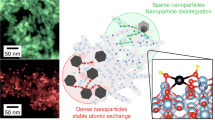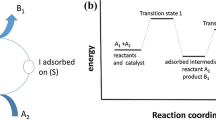Abstract
A model is presented for studying the electrocatalytic activity at an array of catalyst nanoparticles that is deposited on a catalytically inactive support material. The objective is to rationalize effects on apparent reactivity of sizes and packing densities of nanoparticles. In the current version, the focus of the model is on the contribution of the spillover effect of adsorbed hydrogen to the overall rate of the hydrogen evolution reaction. For nanoparticles of fixed size, the current density per catalyst surface area exhibits a peculiar maximum as a function of the surface particle density; the optimum particle density varies with the rate of spillover of adsorbed hydrogen from particle to support and with adsorbate surface diffusion. For fixed particle density, the current density per catalyst surface area increases strongly with decreasing particle size. The model was used to fit experimental current densities for different catalyst particle coverage at varying electrode potentials. A good agreement between experimental data and calculated results was found. The fits provide key parameters of surface processes on the catalyst/support system.








Similar content being viewed by others
Abbreviations
- c b :
-
Proton concentration in bulk solution (mol mL−1)
- D s :
-
Diffusion coefficient (cm2 s−1)
- i c :
-
Current generated at catalyst surface (mA)
- i s :
-
Current generated at support surface (mA)
- j 0 :
-
Current density per catalyst surface area (mA cm−2)
- \( k_{\rm{c}}^{\rm{a}} \) :
-
Hydrogen adsorption rate for Volmer step in HER (s−1)
- \( k_{\rm{c}}^{\rm{d}} \) :
-
Hydrogen desorption rate on catalyst surface (s−1)
- \( k_{\rm{s}}^{\rm{d}} \) :
-
Hydrogen desorption rate on support surface (s−1)
- L :
-
Separation distance of nanoparticles (nm)
- r c :
-
Nanoparticle radius (nm)
- r R :
-
Effective area radius (nm)
- \( \alpha_{\rm{c}}^{\rm{a}} \) :
-
Charge transfer coefficient for Volmer reaction on catalyst
- \( \alpha_{\rm{c}}^{\rm{d}} \) :
-
Charge transfer coefficient for Heyrovsky reaction on catalyst
- \( \alpha_{\rm{s}}^{\rm{d}} \) :
-
Charge transfer coefficient for Heyrovsky reaction on support
- γ s :
-
Atom density on support surface (cm−2)
- γ c :
-
Atom density on catalyst surface (cm−2)
- η :
-
Overpotential (mV)
- θ s :
-
Hydrogen coverage at steady state
- v :
-
Reaction order (Heyrovsky mechanism: 1, Tafel mechanism: 2)
- ρ :
-
Dimensionless radial coordinate, ρ = r/r R
- τ c :
-
Hydrogen relaxation time on catalyst surface (s)
- τ s :
-
Hydrogen relaxation time on support surface (s)
- Гc :
-
Catalyst coverage
References
Eikerling M, Kornyshev AA, Kucernak AR (2007) Physics World 20:32–36
Andreaus B, Maillard F, Kocylo J, Savinova E, Eikerling M (2006) J Phys Chem B 110:21028–21040
Andreaus B, Eikerling M (2008) Device and materials modeling in PEM fuel cells. In: Promislow KS, Paddison SJ (eds) Topics in applied physics, vol 113. Springer, New York, pp 41–90
Eikerling M, Malek K, Wang Q (2008) In: Zhang JJ (ed) PEM fuel cells catalysts and catalyst layers—fundamentals and applications. Springer, Berlin, pp 381–446
Matsumoto T, Komatsu T, Nakano H, Arai K et al (2004) Catal Today 90:277–281
Cho Y, Choi B, Cho Y, Park H, Sung Y (2007) Electrochem Commun 9:378–381
Vielstich W, Lamm A, Gasteiger HA (2003) Handbook of fuel cells. Wiley, Chichester
Wieckowski A, Savinova ER, Vayenas CG (2003) Catalysis and electrocatalysis at nanoparticle surfaces. Dekker, New York
Malek K, Eikerling M, Wang Q, Navessin T, Liu Z (2007) J Phys Chem C 111:13627
Xia ZT, Wang QP, Eikerling M, Liu ZS (2008) Can J Chem 86:657–667
Liu J, Eikerling M (2008) Electrochim Acta 53:4435–4446
Song DT, Wang QP, Liu ZS, Eikerling M, Xie Z, Navessin T, Holdcroft S (2005) Electrochim Acta 50:3347–3358
Ficicilar B, Bayrakceken A, Eroglu I, Power J (2009) Sources 193:17–23
Garcia A, Paganin V, Ticianelli E (2008) Electrochim Acta 53:4309–4315
Martin Jacobus Johan Jak. Thesis. 1971
Kumar S, Zou S (2006) Electrochem Commun 8:1151–1157
Eikerling M, Meier J, Stimming U (2003) Z Phys Chem 217:395–414
Pandelov S, Stimming U (2007) Electrochim Acta 52:5548–5555
Su L, Wu B (2004) J Electroanal Chem 565:1–6
Liu W, Wu B, Cha C (1999) J Electroanal Chem 476:101–108
Lasia A (2006) J Electroanal Chem 593:159–166
Eikerling M, Meier J, Stimming U (2003) Z Phys Chem 217:395–414
Schubert MM, Hackenberg S, van Veen AC, Muhler M, Plzak V, Behm RJ (2001) J Catal 197:113–122
Harding CJ, Kunz S, Habibpour V, Heiz U (2008) Chem Phys Lett 461:235–237
Yang RT, Wang Y (2009) J Am Chem Soc 131:4224–4226
Andreaus B, Eikerling M (2007) J Electroanal Chem 607:121–132
Denisov SI, Trohidou KN (2002) Phys Status Solidi A 189:265–268
He L, Chen C, Wang N, Zhou W, Guo L (2007) J Appl Phys 102:103911
Surve M, Pryamitsyn V, Ganesan V (2006) Langmuir 22:969–981
Tanaka T (2002) Methods of statistical physics. Cambridge University Press, Cambridge
Ashcroft NW, Mermin ND (1976) Solid state physics. Saunders College, Philadelphia
Altmann SL, Barton W, Mallett CP (1978) J Solid State Phys 11:1801–1812
Dechialvo M (1995) J Electroanal Chem 388:215–224
Ludwig A (2006) ChemPhysChem 7:985–991
Hong S, Rahman TS (2007) Phys Rev B 75:155405–155415
Pajonk GM, Teichner SJ, Germain JE (eds) (1983) Spillover of adsorbed species. Elsevier, Amsterdam
Pozzo M, Alfe D (2009) Int J Hydrogen Energy 34:1922–1930
Haug K, Jenkins T (2000) J Phys Chem B 104:10017–10023
Triwahyono S, Jalil AA, Hattori H, Nat J (2007) Gas Chem 16:252–257
Paul JF, Sautet P (1996) Phys Rev B 53:8015
Mitsui T, Rose MK, Fomin E, Ogletree DF, Salmeron M (2003) Surf Sci 540:5–11
Ogura S, Fukutani K, Wilde M, Matsumoto M, Okano T, Okada M, Kasai T, Dino WA (2004) Surf Sci 566:755–760
Karlberg G, Nørskov J. Private communication
Polyanin AD (2002) Handbook of linear partial differential equation. Champman & Hall/CRC
Carslaw HS, Jaeger JC (2004) Conduction of heat in solids. Oxford University Press, New York
Lebedev NN (1965) Special functions and their applications. Prentice Hall, New Jersey
Christmann K (1988) Surf Sci Rep 9:1–3
Hammer B, Norskov JK (2000) Adv Catal 45:71–129
Hammer B, Norskov JK (1995) Surf Sci 343:211–220
Patterson JD, Bailey BC (2007) Solid-state physics: introduction to the theory. Springer, Berlin
Roudgar A, Gross A (2003) Phys Rev B 67:033409
Su L, Wu BL (2004) J Electroanal Chem 565:1–6
Lasia A (2006) J Electroanal Chem 593:159–166
Acknowledgment
Liya Wang and Michael Eeikerling gratefully acknowledge the financial support of this work by the Discovery Grants program of the Natural Sciences and Engineering Research Council of Canada and by the Accelerate BC Graduate Research Internship Program.
Author information
Authors and Affiliations
Corresponding author
Appendix
Appendix
Using ρ = r/r R performing a Laplace transformation of Eq. 8 for ν = 1 gives
The general solution is
The Laplace transform of the boundary condition at \( {\rho_{\rm{c}}} = {{{r_{\rm{c}}}} \mathord{\left/{\vphantom {{{r_{\rm{c}}}} {{r_{\rm{R}}}}}} \right.} {{r_{\rm{R}}}}} \), Eq. 10, is
where the second step follows from Eq. A2.
The Laplace transform of the boundary condition at ρ = 1, Eq. 13, is
From Eqs. A3 and A4, we obtain
where
By inverse Laplace transformation of Eq. A5, \( {L^{ - 1}}\left\{ {\tilde{\theta }\left( {\rho, s} \right)} \right\} \), we get
The integrand is a single-valued function of s with a simple pole at s = 0 and simple poles at \( \sqrt {{s + k_{\rm{s}}^{\rm{d}}}} = - \alpha_n^2 \), where ±α n are the roots of
The residue at the pole s = 0 gives the stationary solution, θ s(ρ)
To find the residues at \( s = - \kappa \alpha_{\rm{n}}^2 \), we need
According to the properties of Bessel function, the recurrence Eq. A8, and the Wronskian relation, we find
where
Therefore,
Using the definition \( \xi = \frac{{k_{\rm{c}}^{\rm{a}} + k_{\rm{c}}^{\rm{d}}}}{{k_{\rm{c}}^{\rm{a}}}} \) and \( \frac{{k_{\rm{c}}^{\rm{a}} + k_{\rm{s}}^{\rm{d}}}}{{k_{\rm{c}}^{\rm{a}}}} = \frac{{ - 2{\alpha_n}\left[ {{Y_1}\left( {{\alpha_n}} \right){J_1}\left( {{\rho_{\rm{c}}}{\alpha_n}} \right) - {J_1}\left( {{\alpha_n}} \right){Y_1}\left( {{\rho_{\rm{c}}}{\alpha_n}} \right)} \right]}}{{k_{\rm{c}}^{\rm{a}}\left[ {{Y_1}\left( {{\alpha_n}} \right){J_1}\left( {{\rho_{\rm{c}}}{\alpha_n}} \right) - {J_1}\left( {{\alpha_n}} \right){Y_1}\left( {{\rho_{\rm{c}}}{\alpha_n}} \right)} \right]}} = \frac{{ - 2{\alpha_n}}}{{k_{\rm{c}}^{\rm{a}}}}C\left( {{\alpha_n}} \right) \) in Eq. A13 gives
Finally, we obtain Eq. A14 in the form of Eq. 14,
where the function \(f{\left( {J_{n} {\left( r \right)},Y_{n} {\left( r \right)}} \right)}\) is composed of Bessel functions of the first and second kind,
Rights and permissions
About this article
Cite this article
Wang, L., Stimming, U. & Eikerling, M. Kinetic Model of Hydrogen Evolution at an Array of Au-Supported Catalyst Nanoparticles. Electrocatal 1, 60–71 (2010). https://doi.org/10.1007/s12678-010-0012-3
Published:
Issue Date:
DOI: https://doi.org/10.1007/s12678-010-0012-3




